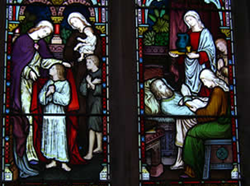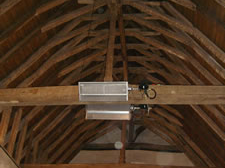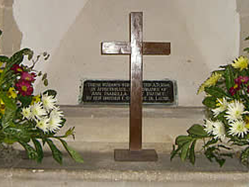Mediaeval Church
The Medieval High Altar
The medieval chancel, or high altar would have been dedicated, as was customary, to the patronal saint: John the Baptist and his Decollation. We hear of this altar, and its light, in the wills of Doddington's benefactors. In 1465 Thomas Holmeston left a bushel of corn for the benefit of St John's light, that is, toward the cost of tapers or candles. In the same year Thomas Howchon left it two bushels of barley. In 1507 Andrew Dungate (the Dungates of Dungate Street in Kingsdown had succeeded the Bourne's at Downe Court "about the latter end of King Henry VI's reign" - he died in 1471) left the substantial sum of 4d to St John the Baptist's light.
The Lost North Aisle
The nave once had two medieval aisles. traces of three pointed arches of a demolished Early English north arcade have been found on the exterior of the north wall. We do not know when or why this north aisle was taken down.
Lost Medieval Shrines
In the medieval Doddington church there were at least three lights for altars and images whose dedications are now known, but whose locations have been lost. These, identified from fifteenth and sixteenth century bequests, were probably situated in the nave or the south aisle. Most unusual was the Alms Light, of which, in Kent, only one other is known - in the large church of St Clement, Sandwich. In 1478 William Mayhew left 4d "To an Almes Light in the church" at Doddington. In the fifteenth century the Doddington Herse Light received at least two bequests. In 1465 Thomas Howchon left two bushels of barley "To the lights about the Herse" and in 1473 Richard Rylkes one bushel of barley "To the Herse Light" . At the beginning of the sixteenth century, and probably earlier for this "popular" saint, there was also a light to St Katherine, to which Andrew Dungate of Downe Court left 4d in 1507.
The Rood
before the Reformation, set high above the east end of the nave, was the Great Rood (crucifix) that would have been accompanied, on either side, by large painted or gilded images of the Virgin Mary and St John the Evangelist, and possibly other saints as well. In some medieval churches the Rood and saints figures were suspended from the roof, but from archaeological evidence it appears that at Doddington they probably stood on the carved oak Rood beam that spanned the chancel.
The Rood Beam
From fragments of the medieval Doddington Rood Beam (the largest 5'4"long) discovered among the timbers in the nave roof in 1902 and 1907 - a most rare discovery in England - it is now possible to reconstruct its appearance with detailed information about dating, size, position, design and decoration. The Rood Beam was found to have been thus 12.5" in height from edge to edge, and 3" in width.
It was indeed fortunate that these fragments of the doddington Rood beam were examined by the antiquary and the twentieth century authority on Rood beams, lofts , and screens, Aymer Vallance FSA (of Aymers, Sittingbourne, whose family had for centuries been associated with Kent) since the fragments themselves were "lost' during the change of vicars at Doddington in 1920. Vallance published a photograph of the fragments in his monumental book 'English Church Screens Being Great Roods Screenwork & Rood-Lofts of Parish Churches in England & Wales (1936) plate 12. It is from Vallance's discussion there, and his lecture to the Society of Antiquaries in London where he exhibited two of the fragments, that our information now comes.
According to Vallance, a complete pattern of the carving could be made out, a purely architectural design that "appeared to have been executed shortly before the middle of the thirteenth century" He explained that :
"The design.. consists of an arcade of trefoil-cusped arches, wide in proportion to their height, with an average centering of 10.5 inches. From the crown of the arch to the level of the springing measures 5.5 inches While the columns are short and sturdy, not exceeding 4.5 inches in height, capital included, down to the bottom. The capitals and bases are of plain moulding. The carving exhibits little attempt at modeling, but is in simple, low relief throughout, except where a good effect of depth and shadow is obtained by the workmanlike device of a bold, angular hollow, sunk from the extremity of each cusp to the opposite point in the arc."
The arcade design on the Rood beam showed no sign of a stop at either end, nor were there any mortise holes on the under surface, that suggested support only at the ends, probably, as was usual, sunk in the walls, and not attached to any substructure of Rood loft or screen. The upper face of the beam, however, had two mortise holes in the fragments alone, centering three feet apart and 4.25 " and 4.75" long, probably to help support figures of saints standing above. Since the beam was carved, if with a somewhat variant design, with equal finish back and front, it must have been fixed to be seen from two sides, east and west.
The Rood Lights
At Doddington, as in other parish churches, it was customary to burn lights such as lamps, branches and candelabra before the Great Rood. These were usually suspended from the roof by cords or chains, and were maintained by regular parish funds, if not, provided for by individual benefactions. We hear of four such bequests at Doddington at the end of the fifteenth and beginning of the sixteenth centuries. Two bushels of barley were left to the "Light of the holy Cross" by Thomas Howchon (1465) and Richard Rylkes (1473) while in 1499 Joan, Widow of Robert Okynfold, left it "a taper of wax," and in 1507 Andrew Dungate of Downe court left "To the High Cross one ewe".
The Rood Screen
Below the Rood beam, but as we have seen not attached to it, was a wooden Rood Screen, whose design has been lost. The base of the Rood screen, however remains, worked up into the box pew on the south side of the entrance.
The Rood Loft
Above the Rood screen stood the Rood loft, at Doddington a gallery made of wood erected in the fifteenth century that extended across the nave and the south aisle. Rood lofts were usually constructed in the later medieval period when the introduction of "priksong" (part-singing) into the services required a larger number of singers, and also a place for an organ or other instrumental accompaniment.
While nothing now remains at Doddington of the Rood loft itself, the fifteenth century alterations made to the stonework, especially the easternmost nave arcade, to accommodate it are still to be seen. The object was to provide headroom in the loft so that people might walk from the "gangway" above the east end of the south aisle across to the Rood loft in the nave unobstructed by the intervening arcade without the difficulty of cutting a passage through the stone arcade spandrel. The method used at Doddington was to take down the east side of the east arcade, and rebuild it so that the arch would spring from a higher level. Thus, the impost on the east side was made 3'10" higher than that on the west side and the imposts on the other two arches to the west. The resultant "rampant arch" and other distortions to the stonework, now all too visible, were masked by the Rood loft's parapet. However disfiguring today, these medieval alterations for the Roof loft at Doddington are of notable architectural interest as illustrating the peculiar arrangement to circumvent low arcades that was largely confined to Kent parish churches. Other examples are at Lynsted, Sittingbourne, Tenterden, Biddenden, Cranbrook, and Aylesford.
The Rood Loft Stairs
At Doddington access tot he Rood loft was by a (probably narrow) stairway, traces of which have been found toward the east end of the south wall in the south aisle.
The Sanctus Bell
Before the Reformation Doddington, like most churches, had a Sanctus, or as it was popularly called "Saunce" bell which would have been sounded at the Office of the Mass, as the priest said the opening words of the Sanctus ("Holy, Holy, Holy, Lord god of Sabbath...") so that all might make adoration. The Sanctus bell was generally hung so that its sound might be heard both inside and outside the church. Often the Sanctus bell was in a cote on the gable of the chancel roof, or in a window, and its rope led down into the chancel for convenience of the server at the altar. In some churches, more awkwardly, one of the bells in the tower was used.
How the Doddington Sanctus bell was hung is unknown. These bells were usually small and it is recorded that the Doddington bell was larger than usual from its description. In 1560 the doddington churchwardens presented on Arnold Whitlock, then of Lynsted, but formerly a Doddington churchwarden, who, as they stated "hath a great saunce bell from our church"
Erasmus's Paraphrases
Whitlock, like many another at the chaotic time of the Reformation, had an easy way with church property, but however regrettable his thieving, the contemporary descriptions of such takings are often the only historical records we now have of them. A grasping man, and quite unrepentant, Whitlock was again presented by the doddington churchwardens for theft twelve years later:
"1572 That Arnold Whitlock now dwelling in Lynstead, did take away a Paraphrase in Queen Mary's reign, and hat not restored the same again"
In the reign of the Protestant Edward VI, an English translation made in 1548 of the great reformer Erasmus 'Paraphrases of the New Testament' (written between 1517 and 1524)was ordered to be placed in all parish churches beside the Bible


